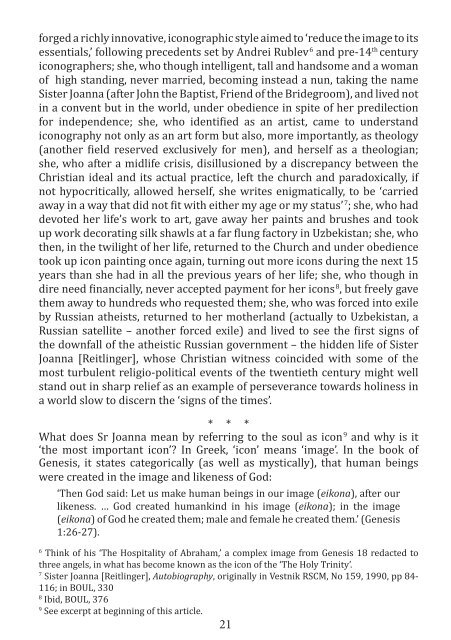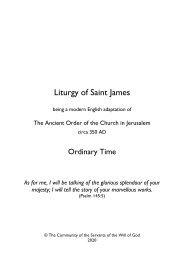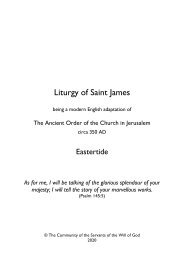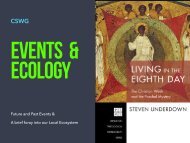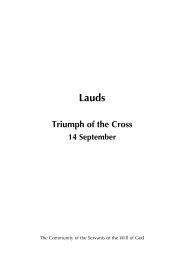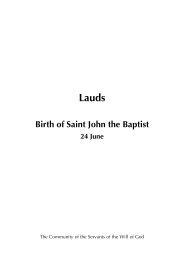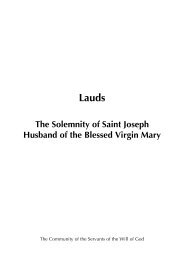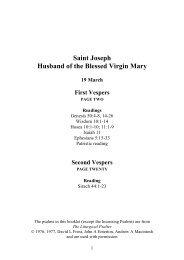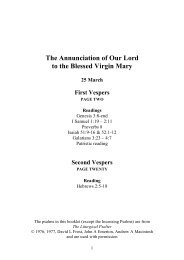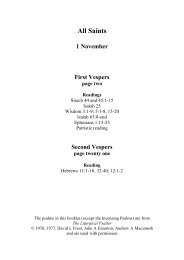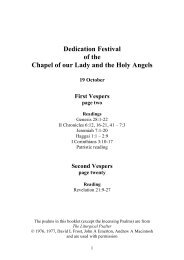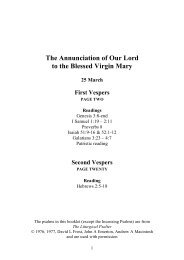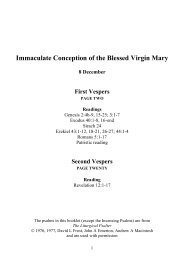In Praise of Holy Women
'Come to the Father' is the official journal of the Anglican Community of the Servants of the Will of God, Sussex, England, a contemplative monastic order for men and women founded in 1938. The aim of the journal is to maintain a dialogue between the Churches - East and West. This issue features articles on Evelyn Underhill, Julia DeBeausobre, Therese of Lisieux, Sister Joanna Reitlinger and Dorothy Day.
'Come to the Father' is the official journal of the Anglican Community of the Servants of the Will of God, Sussex, England, a contemplative monastic order for men and women founded in 1938. The aim of the journal is to maintain a dialogue between the Churches - East and West. This issue features articles on Evelyn Underhill, Julia DeBeausobre, Therese of Lisieux, Sister Joanna Reitlinger and Dorothy Day.
You also want an ePaper? Increase the reach of your titles
YUMPU automatically turns print PDFs into web optimized ePapers that Google loves.
forged a richly innovative, iconographic style aimed to ‘reduce the image to its<br />
essentials,’ following precedents set by Andrei Rublev 6 and pre-14 th century<br />
iconographers; she, who though intelligent, tall and handsome and a woman<br />
<strong>of</strong> high standing, never married, becoming instead a nun, taking the name<br />
Sister Joanna (after John the Baptist, Friend <strong>of</strong> the Bridegroom), and lived not<br />
in a convent but in the world, under obedience in spite <strong>of</strong> her predilection<br />
for independence; she, who identified as an artist, came to understand<br />
iconography not only as an art form but also, more importantly, as theology<br />
(another field reserved exclusively for men), and herself as a theologian;<br />
she, who after a midlife crisis, disillusioned by a discrepancy between the<br />
Christian ideal and its actual practice, left the church and paradoxically, if<br />
not hypocritically, allowed herself, she writes enigmatically, to be ‘carried<br />
away in a way that did not fit with either my age or my status’ 7 ; she, who had<br />
devoted her life’s work to art, gave away her paints and brushes and took<br />
up work decorating silk shawls at a far flung factory in Uzbekistan; she, who<br />
then, in the twilight <strong>of</strong> her life, returned to the Church and under obedience<br />
took up icon painting once again, turning out more icons during the next 15<br />
years than she had in all the previous years <strong>of</strong> her life; she, who though in<br />
dire need financially, never accepted payment for her icons 8 , but freely gave<br />
them away to hundreds who requested them; she, who was forced into exile<br />
by Russian atheists, returned to her motherland (actually to Uzbekistan, a<br />
Russian satellite – another forced exile) and lived to see the first signs <strong>of</strong><br />
the downfall <strong>of</strong> the atheistic Russian government – the hidden life <strong>of</strong> Sister<br />
Joanna [Reitlinger], whose Christian witness coincided with some <strong>of</strong> the<br />
most turbulent religio-political events <strong>of</strong> the twentieth century might well<br />
stand out in sharp relief as an example <strong>of</strong> perseverance towards holiness in<br />
a world slow to discern the ‘signs <strong>of</strong> the times’.<br />
* * *<br />
What does Sr Joanna mean by referring to the soul as icon 9 and why is it<br />
‘the most important icon’? <strong>In</strong> Greek, ‘icon’ means ‘image’. <strong>In</strong> the book <strong>of</strong><br />
Genesis, it states categorically (as well as mystically), that human beings<br />
were created in the image and likeness <strong>of</strong> God:<br />
‘Then God said: Let us make human beings in our image (eikona), after our<br />
likeness. … God created humankind in his image (eikona); in the image<br />
(eikona) <strong>of</strong> God he created them; male and female he created them.’ (Genesis<br />
1:26-27).<br />
6<br />
Think <strong>of</strong> his ‘The Hospitality <strong>of</strong> Abraham,’ a complex image from Genesis 18 redacted to<br />
three angels, in what has become known as the icon <strong>of</strong> the ‘The <strong>Holy</strong> Trinity’.<br />
7<br />
Sister Joanna [Reitlinger], Autobiography, originally in Vestnik RSCM, No 159, 1990, pp 84-<br />
116; in BOUL, 330<br />
8<br />
Ibid, BOUL, 376<br />
9<br />
See excerpt at beginning <strong>of</strong> this article.<br />
21


